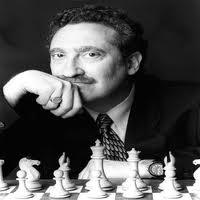
Pandolfini's Puzzler #45 - Imitation: The Sincerest Form of Replication
Professor: Hello, class. Why so pale and wan?
Class: (No response.)
Professor: Well, allow me to enliven your day by introducing two new classmates, Thomas and Rachel.
Everyone smiled guardedly.
Professor: I believe Zephyr and Lucian were going to make a joint presentation today.
Zephyr: We haven’t forgotten, Professor.
Lucian: Yeah, we haven’t forgotten either.
Professor: From a pool of 3,000 positions, you had to pick ten examples and connect them in an instructional lesson.
Zephyr: We’ve done that, and we’ve come up with a storyline.
Professor: Storyline? What do you mean? What did you do?
Lucian: I guess we tried to replicate you.
Professor: This should be interesting.
Ryan: Maybe.
Professor: Lucian, I believe you were going to speak first.
Lucian stepped up to the demo board.
Lucian: Thank you, Professor. Please examine this first position.
Question 1: Can White force a win?
Zephyr: If I may, Lucian, I’d like to ask a helpful question.
Lucian: A rhetorical question? Go right ahead.
Zephyr: Should White capture the pawn on f6 or h6?
Hale: What’s that? A trick question?
Everyone smiled. It was patently obvious that Zephyr was trying to mislead the class for didactic purposes. Even the new kids, Thomas and Rachel, got into the spirit of it.
Rachel: That was curious.
Thomas: Well, I’m curious enough to see the next example.
Lucian: Certainly. And here it is.
Question 2: Can White force a win?
Zephyr: I think you can see this problem looks different.
Rachel: Superficially, perhaps, but I don’t think the outcome is that different.
Thomas: Curious or not, the theme is ostensibly the same.
Rachel and Thomas were correct. They were starting to feel part of the group. With the problem behind them, everyone was ready for more.
Lucian: Let’s stay similar in time and space.
Ryan: Oh yes, chess, the final frontier.
Question 3: Can White force a win?
Zephyr: Let me give you a clue. Don’t think in terms of astronomical space and geologic time.
Lucian: That’s the worst clue I’ve ever heard.
Nervous smiles couldn’t stop the newly formed group from quickly finding the right answer. They were also able to joke about the problem, especially about space and time.
Lucian: Time for the next problem.
Zephyr: We even have space for it.
Question 4: Can White force a win?
Ryan: That’s essentially the same problem.
Zephyr: Actually, there’s a small difference.
Hale: What, on the subatomic level?
Professor: Very funny. Now please solve the problem.
To be sure, the class took into account the small dissimilarity and solved the problem. Time and space were had by all.
Lucian: Well, how about one more problem to round off my part of the subject?
Hale: What is the subject, anyway?
Zephyr: Probably, it’s easier to describe than state.
Lucian: It has to do with forcing the opponent into a kind of self mate with an unexpected pawn.
Ryan: That clears that up.
Question 5: Can White force a win?
A nanosecond went by. The class responded enthusiastically (well, for them), and they solved it with something like alacrity. The group was ready for Zephyr’s part of the presentation.
Zephyr: I suppose it’s my turn.
Professor: Yes it is. Please proceed.
Zephyr: I’m changing the focus slightly.
Rachel: No more rook-pawns?
Zephyr: No, I thought we’d play with knight-pawns. Let’s begin with an impractical example for practical purposes.
Hale: What’s that, a new problem-solving strategy?
Zephyr: No, just a way to begin my part of the talk.
Question 6: Which rook should White take?
Thomas: Another trick question?
Actually, the group dismissed the question. It was seen as even less relevant than the problem, but funny.
Zephyr: OK, that setup didn’t come from a real game.
Lucian: Unfortunately, it came from somewhere, like from a knight-mare.
Zephyr: So let’s get back to real life and our next position.
Question 7: What is White’s best move?
Ryan: Ha! A pawn still becomes an unexpected monster.
Hale: I agree. It is kind of monstrous.
It didn’t take long to do away with the monstrosity. As always, the class was eager for more.
Zephyr: How about taking a look at this next grotesquery?
Question 8: What is White’s best move?
Rachel: I got it!
She had gotten it, too, and so had everyone else.
Thomas: Many of these examples seem like simplified versions of much harder compositions.
Zephyr: Does that mean you’re ready for problem number nine?
Lucian: Number nine? I love to hear that Beatles' song sung.
Zephyr: OK. Join the chorus when the class disagreeably sings the next answer out of tune.
Question 9: What is White’s best move?
Lucian: One cautionary word. Don’t step into stalemate.
Zephyr: Oh, is that what we stepped into?
This problem needed an extra couple of minutes, since the initial analysis proved to be malodorous. But the answer was soon found and everyone was ready for the last example and some fresh air.
Question 10: What is White’s best move?
It took the session’s last five minutes, but the group worked out what appeared to be a winning line that relied on the b-pawn.
Rachel: That’s cute, but I’m not sure we haven’t missed anything.
Thomas: Maybe there’s another kind of win.
Ryan: Maybe not.
Professor: Well, I enjoyed that lesson. The theme was a bit unusual.
Hale: If not obtuse.
Professor: Nevertheless, I loved how you worked together and I think your storyline held up. How were you able to do it?
Zephyr and Lucian: We just tried to replicate you.
Answer below - Try to solve ProfessorPando's Puzzle first!
ANSWER #45
About problem 1, the class realized that neither pawn (the f6-pawn or the h6-pawn) should be captured. Instead, White has a forced mate with the originally blocked up h-pawn.
The winning variation is 1. g6! hxg6+ 2. Kxf6 g5 3. Kf5 g4 4. h3xg4 mate!
In problem 2, White has a forced mate in four moves. It begins with a rook sac, 1. Rh3+! (to obstruct h3). The line finishes 1…gxh3 2. Kf3 g4+ 3. Kf4 g3 4. hxg3 mate. Once again, the initially blocked rook-pawn delivers the coup de grâce. Black is forced to mate himself (or, as Zephyr, Hale, Ryan, and Rachel would insist, herself).
The solution to problem 3 is 1. Ra6+! bxa6 2. b6! axb6+ 3. Kc4 (or Kc6) b5+ (forced) 4. Kc5 b4 (forced) 5. axb4 mate! Once again, the modest rook-pawn gives the checkmate, with Black forced into a type of self mate.
For problem 4, White uses the extra h-pawn to great advantage.
The winning variation starts 1. h3!. To conserve tempi, Black plays 1…a6, and the play concludes 2. h4 a5 (forced) 3. b5cxb5 (forced) 4. h5 b4 (forced) 5. Kc4 b3 6. axb3 mate!. The humble rook-pawn rises to the occasion once again.
Problem 5 leads to another mate by capture with the rook-pawn: 1. Bg6! (preventing Black’s king from escaping at h5) 1…Kg4 (if 1…g4 instead, then 2. Kf4 g3 3. hxg3 mate) 2. Ke4 Kh4 3. Kf3 g4+ 4. Kf4 g3 (as before, Black is forced into self mate) 5. hxg3 mate.
Problem 6 begins with a trick question, as Lucian said. White shouldn’t take either rook. Instead, the preliminary 1. Nb7! mates next move, since the b-pawn will be able to take one of the rooks for sure. Fans of chess problems may recognize this as being a descendant of a famous, more complex, but elegant problem.
Problem 7 is a forced mate for White: 1. Ra6+! bxa6 2. b6+ Ka8 3. b7+ Ka7 4. b8/Q mate. Here, the knight-pawn does the trick.
For Problem 8, White has a forced mate beginning with direct capture, 1. Rxa2!. Black’s only legal response is 1…bxa2, which loses to 2. b4 mate. Yes, it’s another knight-pawn mate.
Problem 9 looks thorny but isn’t. White mates in 3 by 1. Rh5! (not 1. Rh2 because of 1…Bd2) 1…Bd8 2. Ra5+! Bxa5 (now a5 is obstructed) 3. b5 mate. The knight-pawn rides again.
Problem 10 is solved by 1. Qh1+ Kb8 2. Qxa8+ (2. Qc6? is met by 2…Qb7+) Kxa8 3. Kc7 (or 3…Kc8) a5 (Black is forced into this concession, allowing the b-pawn’s free advance) 4. b6 a4 5. b7+ Ka7 6. b8/Q+ Ka6 7. Qb6 mate. If there are other solutions (and there are), may Caissa empower one or more of you to find them.
Take note
Obstruction in chess can mean slightly different actions. The term is often used to signify causing interference, so that the defender’s field of operation encounters a barrier. Sometimes it implies closing a single line. At other times, the obstacle meddles in two lines.
By sacrificing a unit on a particular square, for example, you confront the opponent with an unpleasant choice: to disable one key protecting line or the other. That is, however the opponent captures, the other line is shut down and can no longer be used for defense.
On other occasions, obstruction refers to the actual blocking, usually by sacrifice, of a particular square. Thus, that square can no longer be used, say by a fleeing king, since one of the king’s own units occupies it.
RELATED STUDY MATERIAL
- Now that you know pawns can checkmate, you'll master this lesson;
- Watch FunMasterMike show you a pair of zugzwangs from his own games;
- Check out all of our videos that feature interference!

